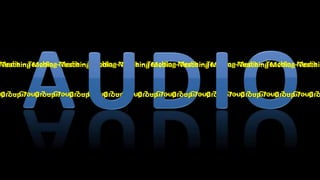
Audio (Teaching Media)
- 1. Teaching Media – Teaching Media – Teaching Media – Teaching Media – Teaching Media – TeachinMedia – Teaching Media – Teaching Media – Teaching Media – Teaching Media – Teaching Media - up 7 – Group 7 – Group 7 – Group 7 – Group 7 – Group 7 – Group 7 – Group 7 – Group 7 – Group 7Group 7 – Group 7 – Group 7 – Group 7 – Group 7 – Group 7 – Group 7 – Group 7 – Group 7 – Gro
- 2. Group 7 • Rifa Endang K. W. (16223026) • Anggita Ramdaniyati N. I. (16223036) 3B
- 3. Outline 1. Hearing and Listening 2. Developing Listening Skills 3. Audio Formats 4. Producing Class Materials on Cassette Tapes 5. Duplicating and Editing Audiotapes 6. Selecting Audio Materials 7. Utilizing Audio Materials 8. Require Learner Participation 9. Evaluate and Revise
- 4. Hearing and Listening • Hearing is a process in which sound waves entering the outer ear are transmitted to the eardrum, converted into mechanical vibrations in the middle ear, and changed in the inner ear into electrical impluses that travel to the brain. • The psychological process of listening begins with someone’s awareness of and attention to sounds or speech patterns (receiving), proceeds through identification and recognition of specific auditory signals (decoding), and ends in comprehension (understanding).
- 5. Developing Listening Skills Hearing is the foundation of listening. Therefore, you should first determine whether all of your students can hear normally. Most systems regularly use speech and hearing therapists to administer audiometric hearing tests to provide the data you need. Technique to improve student listening abilities: • Guide listening. • Give direction. • Ask students to listen for main ideas, details, or inferences. • Use context in listening. • Analyze the structure of a presentation. • Distinguish between relevant and irrelevant information.
- 7. Audiotapes The major advantages of audiotape that you can record your own tapes easily and economically, and when the content becomes outdated or no longer useful, you can erase the magnetic signal on the tape and reuse it.
- 8. Compact Discs The technology of the CD makes it an attractive addition to education programs. Users can quickly locate selections on the disc and can program them to play any desired sequence.
- 9. MP3 (MPEG Audio Layer 3) is an audio compression format that makes large audio files available by shrinking them inton a smaller files that can quickly and easily be captured on the Internet.
- 10. Advantages of MP3 • Inexpensive • Readily available and simple to use. • Reproducible. • Provides verbal message for nonreaders. • Ideal for teaching foreign languages. • Stimulating. • Repeatable. • Portable. • Ease of lesson preparation • Selections easy to locate • Resistance to damage.
- 11. Limitations of MP3 • Fixed sequence. • Doesn’t monitor attention. • Difficulty in pacing. • Difficulty in locating segment. • Potential for accidental erasure.
- 12. Intergration of MP3 The uses of audio media are limited only by the imagination of you and your students. You can use audio media in all phases of instruction-from introduction of a topic to evaluation of student learning. Perhaps the most rapidly growing general use of audio media today is in the area of self-paced instruction.
- 13. Producing Class Materials on Cassette Tapes • Students can use cassette tapes for gathering oral histories and preparing oral book reports. • The teachers can prepare tapes for use in direct instruction, as illustrated by the vocational-technical school example referred to later in this section.
- 14. Duplicating and Editing Audiotapes 1. The Acoustic Method 2. The Electronic Method 3. The High-speed Duplicator Method
- 15. The acoustic method does not require any special equipment, just two recorders. One recorder plays the original tape, and the sound is transferred via a microphone to a blank tape on the recorder.
- 16. The Electronic Method The electronic method avoids this problem. The signal travels from the original tape to the recorder via an inexpensive path cord.
- 17. The high-speed duplicator method requires a special machine. Master playback machines have series of up to 10 “slave units,” each of which can record a copy of th original tape at 16 times its normal speed.
- 18. Before selecting your audio materials, you should have analyzed your audience and stated your objective according to the ASSURE model. Then you are ready to select, modify, or design you audio materials.
- 19. Utilizing Audio Materials 1.Preview the Materials 2.Prepare the Materials 3.Prepare the environment 4.Prepare the learner 5.Provides the Learning Experience
- 20. Student-Based Utilization There are times when students will use audio materials for individual learning and to create their own materials.
- 21. Require Learner Participation Before you begin the lesson, determine how to get and keep your students actively involved. One technique is to give students a set of questions to answer during the listening.
- 22. Evaluate and Revise Determine how effective the audio materials were. You can gather data by making observations, evaluating test result, or discussing the experience with students. You may decide to revise how you use the materials or to modify the materials themselves.
